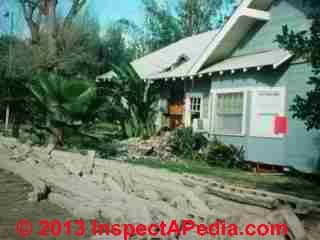 Retaining Wall Damage Diagnosis
Retaining Wall Damage Diagnosis
Descriptions of types of damage to retaining walls & privacy walls, causes, cures
- POST a QUESTION or COMMENT about retaining wall types, designs, materials, and retaining wall guard railings & building codes
Retaining wall damage & privacy damage identification, troubleshooting, cures.
This article describes the different types of damage that can occur to different types of retaining or barrier walls. Damage ranges from cosmetic (lime staining on wet privacy walls) to catastrophic if a tall retaining wall collapses. We discuss frost and water damage to all types of outdoor walls, and rot damage to wood retaining walls.
This article series describes types of privacy walls, retaining walls and retaining wall guard railing requirements, guard railing construction and building codes, and critical safe-construction details for retaining wall guardrails.
We include definitions of important retaining wall terms such as wall surcharge, and we provide diagnostic descriptions & photographs of types of damage to retaining walls & privacy walls.
InspectAPedia tolerates no conflicts of interest. We have no relationship with advertisers, products, or services discussed at this website.
Retaining Wall Damage Diagnosis: Earth Pressure, Frost Heave, Water, Traffic, Rot, or Other
Don't ignore warnings of imminent collapse of retaining walls
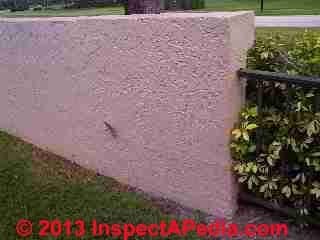 Watch out: in at least some locations collapsing retaining walls can be dangerous. In 2007 the New York Times reported that a 50-foot-high retaining wall behind a hilltop home on Staten Island collapsed, sending
Watch out: in at least some locations collapsing retaining walls can be dangerous. In 2007 the New York Times reported that a 50-foot-high retaining wall behind a hilltop home on Staten Island collapsed, sending
"... an avalanche of concrete blocks weighing hundreds of pounds each into the yards of smaller homes below. A car and a home at the base of the hill were damaged and people in four houses were evacuated, but no one was hurt,...] [1]
The same news article reminded readers that in May 2005 a 150-foot section of a nearly 100-year-old retaining wall above the Henry Hudson Parkway in Manhattan. Parked cars were buried and traffic on the parkway was not only disrupted for hours, but a detour around the repair project lasted for months.
Just the debris removal alone cost more than $1 million. It is noteworthy that there had been early warnings of a problem - sinkholes and voids had appeared behind the wall at least two months previously. Experts had also observed that a new drainage system, intended to relieve the pressure of ground-water build-up behind the retaining wall had not been effective.
Our photo above illustrates a retaining wall that is not in danger of collapse, but nonetheless we can see that water penetrates this wall - notice the little plant growing right out of the wall surface. This wall is located in Boca Raton, FL (or in English, Rat Mouth FL).
Examples of Earth Pressure & Frost-Damaged Masonry & Concrete Retaining Walls
Our photographs below illustrate the two most common types of damage to masonry retaining walls: leaning/bulging/bowing (below left), and frost cracking (below right).
Watch out: the mere presence of weep holes in the face of a masonry retaining wall does not guarantee that the wall won't be destroyed by earth pressure or increased pressures from wet soils and frost. Good drainage behind the wall and weep openings that are kept free running are needed.
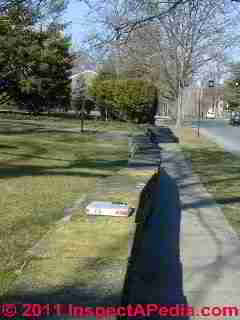
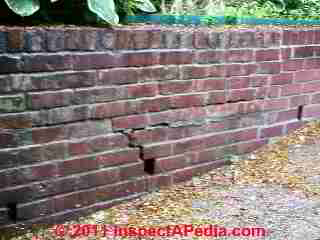
How to Distinguish Between Frost Heave & Earth Pressure Damage to Masonry Retaining Walls
The poured concrete reinforced retaining wall shown at below left is cracking vertically from earth and frost pressure just above its tiny drain opening.
We suspected that the bottom of this wall may have been placed on a footing that was not below the frost line.
A shallow wall footing combined with water and (in freezing weather) frost heaving, can be broken and heaved by those forces.
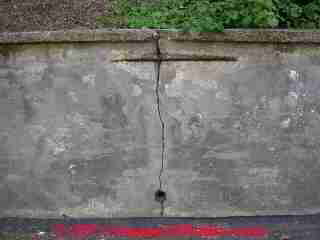 ...
... 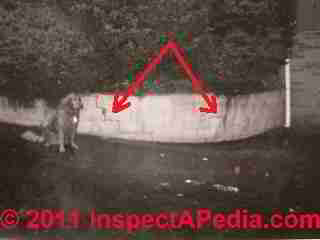
We can often distinguish between vertical frost heave damage and horizontal earth pressure damage to a retaining wall by noticing that frost heaving alone will typically leave the wall face flat in the vertical plane, that is, frost heaves alone won't cause the wall to bulge or lean outwards.
Back in 1986 my dog Katie helped inspect the curved masonry block retaining wall shown at above right. The stair-step cracking in that wall was accompanied by outwards leaning at the wall center and was caused by horizontal earth pressure combined with an absence of any drainage behind or through the wall face.
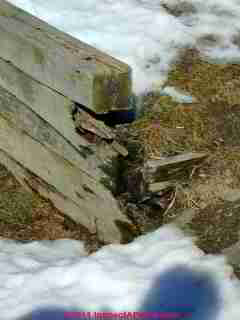 In the vertically-cracked concrete retaining wall at above left, notice that where the steel reinforcing re-bar placed horizontally in the concrete happened to run closest to the surface, exfoliating rust has caused spalling of the concrete surface.
In the vertically-cracked concrete retaining wall at above left, notice that where the steel reinforcing re-bar placed horizontally in the concrete happened to run closest to the surface, exfoliating rust has caused spalling of the concrete surface.
See FOUNDATION CRACKS & DAMAGE GUIDE for an extensive description of types and causes of masonry foundation and wall damage.
Rot Damage to Wooden Retaining Walls
Our low wooden retaining wall photograph (left) illustrates a common rot location that begins at the cut ends of the retaining wall members.
In the center of the photo you will observe the remains of a rotted anchoring retaining wall member as well.
How to Spot Fake "Treated, Rot-Resistant" Landscape Ties that are Rot-Prone
Watch out: wood retaining walls made of "landscape ties" that were not really treated-through with a wood preservative (i.e. are not pressure-treated lumber) are often sold to un-suspecting customers by spraying the wood surface with a green dye.
Dying or staining the exterior of untreated lumber green and then placing it in ground contact does not make for a long-lasting structure in most climates.
Because of its cross sectional size (6" x 6" or larger), some landscape tie lumber appears to have been treated with wood preservative only superficially.
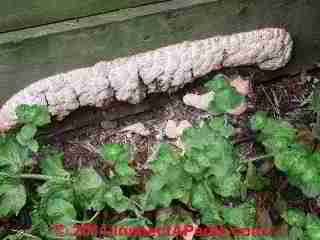 The original end cuts may look "green" having been sprayed superficially at the treatment processing plant but the internal cross section of the wood may be discovered to have not been penetrated by the preservative chemical.
The original end cuts may look "green" having been sprayed superficially at the treatment processing plant but the internal cross section of the wood may be discovered to have not been penetrated by the preservative chemical.
A second retaining wall rot indicator, fungal growth, is shown in photo at left.
If you see mushrooms or tree-ears growing out of a wood retaining wall you can safely assume that the wood is more rotted than meets the eye.
A rotted wood retaining wall may be more costly to repair than you'd first guess, particularly if excavation back into the retained earth is required to install new retaining wall anchors.
But you can observe a clue that will assist in evaluating the rot and insect resistance of the lumber by noticing the extent of penetration through the wood wherever you have made a fresh saw cut through the member.
Earthquake damaged retaining walls
Retaining walls often provided the first obvious and unambiguous indication of the direction of lateral displacement when entering a neighborhood (photo above).
The collapsed concrete block retaining wall shown above fell during the Northridge California earthquake and is described and discussed
at EARTHQUAKE DAMAGE PHOTOS CA 1994
Water Damage to Retaining Walls & Privacy Walls
This discussion now has its very own page found
at RETAINING WALL WATER DAMAGE
Watch out: Water damage to retaining walls and privacy walls ranges in import from cosmetic (photo at below left) to catastrophic collapse that can damage other property or even injure or kill someone.
Reader Comments, Questions & Answers About The Article Above
Below you will find questions and answers previously posted on this page at its page bottom reader comment box.
Reader Q&A - also see RECOMMENDED ARTICLES & FAQs
On 2020-04-11 - by (mod) - how to stop plant damage caused by heat from a nearby retaining wall or block wall or concrete wall
Kevin
Steps to stop plant damage caused by heat from a nearby retaining wall or block wall or concrete wall
I'd need to know more details about your installation, the color of the existing retaining wall, the type of plants that are being harmed, reasoning that demonstrates that it's heat from the retaining wall that is the actual issue, the distance from plants to retaining wall, the sun exposure.
But in general a South-facing retaining wall can in some climate zones gain and reflect heat onto nearby plants or turf causing excessive drying or actual heat damage.
Retaining wall snafu and plant damage examples
- Building a retaining wall in a location where the wall's excavation and footings disturb, cut, or are placed over top of the roots of nearby plants can damage or kill those plants.
- Building a retaining wall using toxic materials such as recycled railroad ties that may leach creosote into the surrounding soil may kill nearby plants (and be a health hazard)
- Using muriatic acid or similar cleaners on a masonry retaining wall may poison nearby soil, killing off plants later put close to the wall
- Using weed killers near a retaining wall can kill off nearby plants that were not intended to be so-treated
- Treating a retaining wall with paints or wood preservatives or water-proofing chemical that cause a toxic runoff into nearby soils
- Installing a retaining wall so as to redirect surface runoff away from an area near the wall may cause soil to be too dry for nearby plants
- Plants that were placed in a very sunny area and that are not sun-tolerant may be damaged independently of the effects of the retaining wall.
- Planting trees or other plants whose root systems normally extend horizontally for a distance greater than the distance between plant and retaining wall can cause distorted (concentrated) root growth that in turn produces weakened plants
Hot Retaining Wall Plant Damage Solutions
Here are some things you can try:
If your concern is that sunlight is heating the retaining wall and reflecting on to nearby plants,
- painting the retaining wall with a light color will reduce its heat uptake.
- install a trellis against the retaining wall to block some of the sun's heat gain into the wall
- protect the wall surface or the nearby plants with a landscaping fabric or shade cloth to block both heat gain and reflected heat
- be sure that your plants near the retaining wall are getting enough water
- check the soil pH to be sure that soil conditions in the area are not the cause of poor plant growth or plant deaths
On 2020-04-11 by Kevin - How do i stop concrete retainer walls from heating up because it kill my plants?
How do i stop concrete retainer walls from heating up because it kill my plants?
On 2020-01-14 - by (mod) - rely on indoor sump pump to prevent flooding?
Dana
While indoor sumps and sealing gaps and cracks are helpful "insurance" against actual flooding, it is never the best approach to let the water in and then try to get rid of it, nor to try to live life as the little Dutch boy stopping the collapse of a dam by holding his finger on the leak.
Let's instead go outside to see where water is coming from and how we can get it away from the home.
The no. 1 source is usually roof drainage spilling by the foundation
the no. 2 water source is usually in-slope grade towards the building
And of course on older buildings the footing drain system may no longer work.
See details at
BASEMENT WATER ENTRY PREVENTION
On 2020-01-14 by Dana - my basement flooding due to the sump pump not plugged in
Long story. I begin with my basement flooding due to the sump pump not plugged in to so much rain the pumps can't handle the water. I ha be 2 pumps. Got the indoor system put in. Though problem was fixed. Nope.
Must have been a drain hole in floor. .filled that. Last night we got a great amount of rain.
Woke up this morning with water coming in from door jam, outside retaining wall meets door.
So is the system not working or is the retaining wall and bottom of door just rotten from years of moister? I've had enough. Please help.
On 2019-10-16 by Anonymous
can you lend advice or direction as to where to get help without a picture (the pictures are from the neighbor and are difficult to see)
On 2019-10-16 by (mod) -
You can post photos 1 per comment using the add image button
On 2018-10-03 by (mod) - contractor proposes adding a new retaining wall - is this enough?
You ask a very important and reasonable question but not one that can be answered by text messages.
You need an on-site expert opinion and expertise you trust
perhaps you could speak to the engineer or even have a paid consult.
I would be very skeptical about a repair of a bulged or leaning foundation wall that only depends on inserting concrete into the hollow blocks.
The typical repair the use of Steel rebar in the wall or plasters against the wall or even wall reconstruction and of course steps to stop the cause of the damage in the first place.
You also need to have an evaluation or any impact on the structure that may have already occurred because of foundation movement.
This Q&A were posted originally at FOUNDATION REPAIR METHODS
On 2018-10-03 9 by Stephanie
Hi I'm in the process of purchasing a house. The appraiser requested a foundation inspection, the seller had a contractor come out and look.
The contractor is suggesting to fix the foundation problem by drilling 2 inch holes in the already weakened block and pouring mortar inside.
One wall is protruding by 3 inches due to the sloped driveway pushing against the wall, there is an old retaining wall there that built in the 90's that is falling apart. I'm pretty sure the correct way to fix this one wall is to dig around that wall from outside add additional blocks for support and a new retaining wall.
The seller agree with with the contractor they have know him for some time and trust him.
He's not a structural engineer but he occasionally works for one. And the structural engineer is willing to sign off on this. What should I do?
On 2018-10-21 by (mod) - can a soccer ball cause bulging in a retaining wall ?
Lucy
There is no way that a soccer ball would cause bulging in a retaining wall, not to mention that the bulging is in the opposite direction. However keep your kids away because if the wall falls on them they could be killed
On 2017-05-27 by Lucy - neighbour has a retaining wall that borders our property line.
Our neighbour has a retaining wall that border our property line. It is cement block construction and would have been built in the early 90's.
It is about 20 feet high at its greatest height and tapers to about 5 feet high. The 5 foot portion of it which is about 20 feet long is on one side of our backyard.
They just had someone come and look at it as it is bulging slightly in this section. This person says that it is likely caused by water seeping from their yard into the retaining wall which is putting pressure on the wall. There are water marks to indicate this.
Our neighbour is very concerned about soccer balls from my son and his friend hitting the wall as well as him climbing onto the wall to go up into their yard to retrieve balls. I am definitely getting my son to stay away from the wall and to not shoot balls toward the wall but I am curious, can a soccer ball hitting the retaining wall cause it to buckle or damage? Thank you!
Question: retaining wall damaged by nearby buried oil tank
21 January 2015 mike rose said:
my neighbor has a abandon oil tank that has a certificate saying it was done right i question this.The big problem is the tank sets behind a retaining wall that is 6 inches from my property line and is collapsing and has been failed by a engineer. my lawyer says they have been notified with the report and we really can't do anything.
i am going to check for soil contamination the tank is from 1964 and the tank was abandon in 1992.and is still in the ground and has a sink hole developing above it.can i do anything
Reply:
Mike
If an "abandoned" buried oil storage tank is collapsing that is certainly a potential hazard in several regards and it has not been properly abandoned.
Details about proper oil storage tank abandonment, regulations, and safety or environmental concerns are found
at OIL TANK ABANDONING PROCEDURE
I suspect that what your neighbor might have is a document stating that there was no evidence of leakage - which would have permitted the tank to be abandoned in place. But that abandonment, properly conducted, would have included cleaning the tank and filling it with sand or another suitable material.
To check for soil contamination one would need to collect soil samples close to the tank and to a depth of the tank's bottom.
If necessary notify the owner and building authorities of a small but potentially dangerous local sink hole condition as a child or possibly even an adult falling into such an opening could be very serious, even fatal.
On 2012-08-22 by Sam Przymus
I have a 50 year old home in Indiana. We are in an extreme drought. I noticed around my concrete patio that the ground moved away from the concrete by over an inch.
I also saw that the patio itself had shifted. This was about a month ago.
About 2 weeks after that I saw that the concrete slab outside the basement walk out had split in two and had split the concrete block retaining wall vertically in two, even completely through the block not the seam. Last week I looked up and the brick had split down the wall following the seam, this followed into the concrete block foundation wall of the house.
A couple of days later I noticed the screen door was no longer latching and saw that the frame had shifted 1/4". The brick around my son's window has also pulled away. I then saw a couple of days ago a crack in the floor starting at the door frame that was shifted.
This crack is at least a 1/4" wide and travels all the way across the basement floor and up the opposite wall, following the seam. The crack gets smaller as it goes up the wall. What can I do to repair this and should I be worried about further structural damage. Thanks.
...
Continue reading at RETAINING WALL WATER DAMAGE or select a topic from the closely-related articles below, or see the complete ARTICLE INDEX.
Or see these
Recommended Articles
- BLOCK FOUNDATION & WALL DEFECTS
- BULGE or LEAN MEASUREMENTS in retaining walls or in masonry foundations
- FOUNDATION CRACK DICTIONARY diagnose cracks & movement in masonry retaining walls
- FOUNDATION DAMAGE SEVERITY evaluate the seriousness of movement, cracks, leaning, bulges in masonry walls & foundations
- RETAINING WALL DESIGNS, TYPES, DAMAGE - home
Suggested citation for this web page
RETAINING WALL DAMAGE at InspectApedia.com - online encyclopedia of building & environmental inspection, testing, diagnosis, repair, & problem prevention advice.
Or see this
INDEX to RELATED ARTICLES: ARTICLE INDEX to EXTERIORS of BUILDINGS
Or use the SEARCH BOX found below to Ask a Question or Search InspectApedia
Ask a Question or Search InspectApedia
Try the search box just below, or if you prefer, post a question or comment in the Comments box below and we will respond promptly.
Search the InspectApedia website
Note: appearance of your Comment below may be delayed: if your comment contains an image, photograph, web link, or text that looks to the software as if it might be a web link, your posting will appear after it has been approved by a moderator. Apologies for the delay.
Only one image can be added per comment but you can post as many comments, and therefore images, as you like.
You will not receive a notification when a response to your question has been posted.
Please bookmark this page to make it easy for you to check back for our response.
Our Comment Box is provided by Countable Web Productions countable.ca
Citations & References
In addition to any citations in the article above, a full list is available on request.
- In addition to citations & references found in this article, see the research citations given at the end of the related articles found at our suggested
CONTINUE READING or RECOMMENDED ARTICLES.
- Carson, Dunlop & Associates Ltd., 120 Carlton Street Suite 407, Toronto ON M5A 4K2. Tel: (416) 964-9415 1-800-268-7070 Email: info@carsondunlop.com. Alan Carson is a past president of ASHI, the American Society of Home Inspectors.
Thanks to Alan Carson and Bob Dunlop, for permission for InspectAPedia to use text excerpts from The HOME REFERENCE BOOK - the Encyclopedia of Homes and to use illustrations from The ILLUSTRATED HOME .
Carson Dunlop Associates provides extensive home inspection education and report writing material. In gratitude we provide links to tsome Carson Dunlop Associates products and services.


